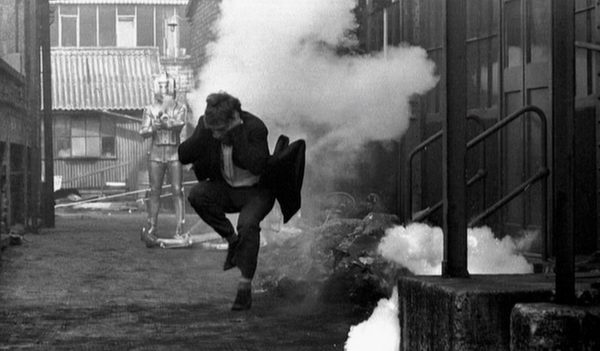|
| ||
|
PRODUCTION CODE VV
TELEPLAY BY DERRICK SHERWIN
STORY BY KIT PEDLER
DIRECTED BY DOUGLAS CAMFIELD
RATINGS 6.9 MILLION
RECOMMENDED PURCHASE 'THE INVASION' DVD (BBCDVD1829) RELEASED IN NOVEMBER 2006.
BLURB INVESTIGATING THE disappearance of an eminent scientist, the Doctor and his companions follow his trail to the London headquarters of International Electromatics, a global supplier of electronic equipment run by the formidable Tobias Vaughan. Teaming up with the newly-formed United Nations Intelligence Taskforce under the command of Brigadier Lethbridge-Stewart, it soon becomes apparent that Vaughan is working to his own sinister agenda. As Cybermen invade in all cities all over the world, can the Doctor convince Vaughan to help him defeat their plan for GLOBAL DOMINATION?
BBC ARCHIVE THE ORIGINAL LIVE ACTION VERSIONS OF EPISODES 1 AND 4 ARE BOTH MISSING, BUT THE BBC DVD RELEASE CONTAINS ANIMATED REPLACEMENTS THAT UTILISE THE SURVIVING OFF-AIR SOUNDTRACKS. |
| |
|
|
|
|
|
The Invasion 2ND NOVEMBER 1968 - 21ST DECEMBER 1968 (8 EPISODES)
Everyone has been asking the same question for years – “Why don’t the BBC just animate Doctor Who’s lost episodes?”- but, deep down, we all knew the answer to the question. It takes time, it costs money, and it there was easier money to be made first through churning out narrated off-air CD soundtracks and awkward MP3-CD reconstructions. However, with it having now seen commercial release as a narration-abridged VHS and a part-narrated audio CD, 2|entertain and Cosgrove Hall have finally joined forces us to bring us The Invasion on DVD, its two missing episodes reanimated in the distinguishing style of the anniversary’s year’s Scream of the Shalka webcast. The significance of this release cannot be overstated.
I first saw The Invasion in the mid-1990s when, to my utter astonishment, my local Blockbuster Video had a copy available for rental. The VHS presented the serial’s six surviving episodes with Nicholas Courtney (the Brigadier) filling in the blanks from the comfort of his armchair. These links gave me little reason to lament the loss of the two missing instalments – from Courtney’s brief précis, little of note seemed to have happened in either, and I was easily able to follow the ongoing narrative; only the TARDIS’s invisibility in the serial’s final scenes gave me pause. Yet when I came to watch Cosgrove Hall’s animated replacements, I was staggered by the layers of plot, character moments and finesse touches that had all been curtailed by the BBC’s senseless junking.
The actual quality of the animation is a little smoother than we’ve become used to, boasting more frames per second than any Doctor Who webcast, but it is by no means as fluent as the cartoons that you generally see on television. The episodes have a shaky, slightly disjointed feel that might irritate some, but that I found actually added to their idiosyncrasy. Indeed, I enjoyed them so much that I actually felt a little bit deflated when the serial’s surviving episodes rolled around.
Taken as whole, The Invasion might have one of the blandest billings in the history of Doctor Who, but its question-begging title belies one of the most memorable serials of the Troughton era, if not the entire classic series. There are certain images from the series that have almost subconsciously become part of British culture - the Daleks parading around London in The Dalek Invasion of Earth is one of them; the Autons smashing their way through shop windows in Spearhead from Space is another. This serial’s striking scenes of the Cybermen emerging from the sewers outside St Paul’s Cathedral is every bit as iconic, particularly as it typified a looming change of direction for the programme. Viewers were about to find out that there’s nothing more frightening than a monster on the doorstep.
The previous season’s underground classic, The Web of Fear, introduced us to a certain Colonel Alistair Gordon Lethbridge-Stewart - a stiff-upper-lipped British soldier with a penchant for dry humour and passion to protect his planet. The Invasion sees Lethbridge-Stewart return, duly promoted to brigadier and placed in charge of the British branch of the United Nations Intelligence Task Force (UNIT). In a refreshing change from formula, this story sees the Doctor and his companions actively working with the authorities, as opposed to spending half the narrative trying to convince the story’s besieged goodies that they’re not in league with the baddies. The production team’s intention was to use The Invasion to cement to the Brigadier and UNIT in the foundations of the series so that they could become regulars in the series’ mooted Earth-based seventh season. As such, The Invasion goes above and beyond the standard of most Pertwee era serials in how it presents the paramilitary organisation. Its headquarters in this story rival the lairs of the most extravagant Bond villains, its troops seem to number in the thousands and its resources seem far from limited. Were it not for their every appearance being marred by a horrendously jolly jingle (“More naval than army,” quips Courtney in the commentary), The Invasion might even have been UNIT’s most impressive appearance prior to the series’ revival.
The trade-off is that the eight episodes dwell as much on character subtleties as they do action. The Cybermen don’t even appear until the fourth episode’s Tomb of the Cybermen-plagiarising cliffhanger, and even when they do they’re no more than intimidating, nearly-mute mechanical muscle for the serial’s real villain, the charismatic Tobias Vaughan. This must have frustrated the animators at Cosgrove Hall no end as they laboured on the serial’s almost Cyberman-free first half, but it does make for a far more refreshing story than just another Cyber-rehash.
Vaughan stands out as the most appealing human antagonist of the Troughton era, trumping even The Evil of the Daleks’ abhorrent Theodore Maxtible. Kevin Stoney brings deadly earnestness and frightening self-righteousness to the part, unwittingly pre-empting iconic villains the likes of Davros and Omega. His obsession is chilling, his casual callousness even more so. The Invasion features one of my favourite scenes in the whole of Doctor Who, in which Edward Burnham’s plucky Professor Watkins delivers an emotive speech to Vaughan about how he knows he can’t stand up to torture, and so he has no choice but to do as he’s been bid, but if he ever gets the chance, he’ll kill him. Vaughan, of course, deliberately gives him that chance, and in so doing reveals a truth about himself that pulls his cold ambition into sharp focus. Even with a bulkier, more intimidating redesign that would endure for twenty years, the Cybermen couldn’t hope to compete with such calculated cruelty.
However, what stands out about The Invasion more than anything else is its sense of fun. Vaughan and his Cybermen may be so cold that they’re freezing, but their evil is lightened a little by their stereotypically-ineffectual henchman. Series stalwart Peter Halliday plays the bumbling Packer so very sincerely that he’s constantly bordering on hilarious, particularly in the scenes that he shares with the on-form Patrick Troughton. Even the Brigadier’s staunch devotion to duty is enlivened by his rampant sexism, perhaps best exemplified by the line “Well, you’re a young woman. This is a job for my men”, which inevitably sent the serial’s bonus eye candy, Sally Faulkner’s Isobel Watkins, running for the nearest sewer clutching her camera.
Above: Chris D'oyly John, Wendy Padbury, Nicholas Courtney and Frazer Hines record the DVD commentary
The DVD’s eight episodes are complemented by an impressive fifty-minute documentary that focuses on the making of serial, Evolution of the Invasion. With Nicholas Courtney and Frazer Hines involved, the documentary (and, for that matter, the commentary) couldn’t be anything but raucously entertaining, but for me it is the series’ erstwhile script editor that steals the show. Here Target titan Terrance Dicks divulges masses of behind-the-scenes trivia with his customary wry charm and candour.
The Love Off-Air featurette is almost as intriguing. Before watching it, I had no idea how many well-known Who fans grew up making off-air recordings of their favourite show, Gary Russell, Justin Richards and Mark Ayres amongst them. The rest of the special features are geared more towards the completist - Flash Frames and Character Design each offer fascinating glimpses into Cosgrove Hall’s work reanimating the missing episodes, while the DVD’s two spectacular animated trailers showcase what The Invasion might have looked like had Cosgrove Hall actually had some Cybermen to animate. And, just in case you’re amongst the few who are adamant that Doctor Who should remain inviolate, the set includes the links from the 1993 VHS to bridge the gaps in the action for you.
The Invasion
is a cornerstone in the history of Doctor Who, offering its viewers
a tantalising peek of what lay ahead for the series as it brought the
monsters closer than they had ever been before. The sluggishness and
simplicity of its plot are offset by the radiance of its alluring
characters; the done-to-death Cybermen are saved by their juxtaposition
with contemporary London and, for once, keeping their silver traps shut. I
can only hope that, in years to come, this ambitious DVD release will be
viewed as another such cornerstone – after all, if they can do this for
The Invasion’s lost episodes, what’s to stop them resurrecting the
remaining 106?
|
||
|
Copyright © E.G. Wolverson 2006
E.G. Wolverson has asserted his right under the Copyright, Design and Patents Act 1988, to be identified as the author of this work. |
||
|
When is now? Dialogue explicitly places this serial four years after the “London Event” depicted in The Web of Fear. In the interim, the United Nations Intelligence Taskforce has been formed, with Brigadier Lethbridge-Stewart in command of its British branch. One school of thought places the “London Event” in 1971, broadly in line with The Web of Fear’s prepositional dialogue and the Pertwee-era’s production team’s original intention, with The Invasion following in or around 1975. This also accords with how The Invasion was promoted in the Radio Times when it first aired. However, such a placement is at odds with novels like Who Killed Kennedy, which suggest that the Cyberman invasion occurred in 1969, when the serial was first broadcast.
Please see the UNIT Dating Dossier for further information.
|
||
|
Unless otherwise stated, all images on this site are copyrighted to the BBC and are used solely for promotional purposes. ‘Doctor Who’ is copyright © by the BBC. No copyright infringement is intended. |
||

.jpg)
.jpg)
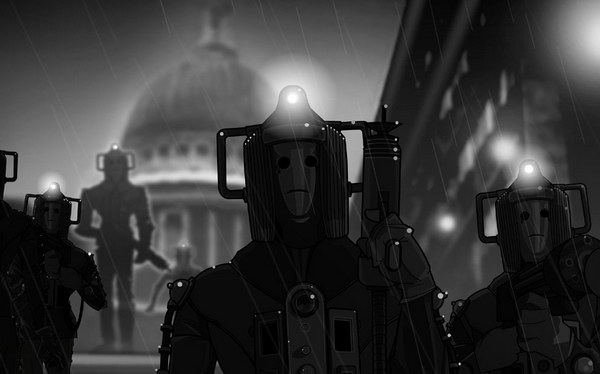

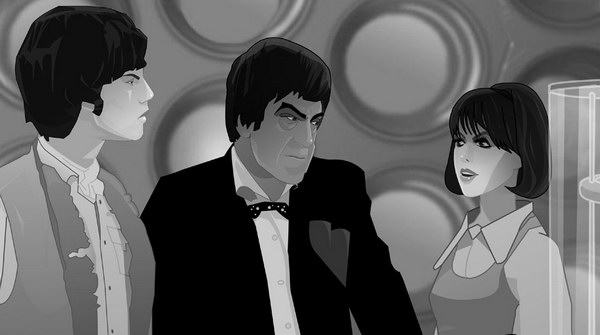
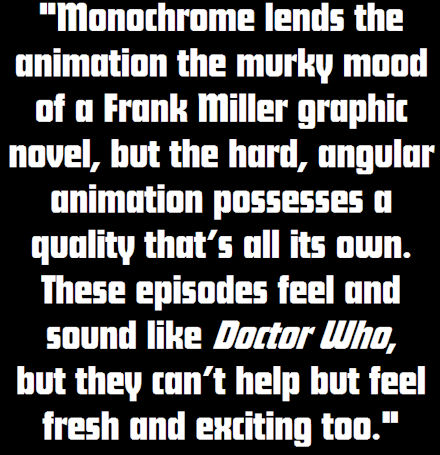 The reconstructed episodes are pleasing in a stylistic sense too.
Monochrome lends the animation the murky mood of a Frank Miller graphic
novel, but the hard, angular animation possesses a quality that’s all its
own. These episodes feel and sound like Doctor Who, but they can’t
help but feel fresh and exciting too. Every aspect of the animation, from
the familiar faces of the cast to the pipe-crowned head of a Cybermen,
seems to capture the essence of the production, while offering viewers its
own slanted take on it. In some instances, this extends to taking some
minor liberties with what is presented – the first episode is gifted a
superfluous spaceship flying past the TARDIS, while the fourth embellishes
the existing drama when Jamie loses his grip on the helicopter’s rope
ladder. Part of me wishes that the animators would have been indulged a
little bit more than they have been – the vetoed idea of having Vaughn’s
image broadcast on a giant Big Brother-style monitor outside
International Electromatics was certainly an inspired one – but had they
been, the two animated episodes would have sat ill amongst their live
action counterparts which are, of course, limited by the standards of
their time.
The reconstructed episodes are pleasing in a stylistic sense too.
Monochrome lends the animation the murky mood of a Frank Miller graphic
novel, but the hard, angular animation possesses a quality that’s all its
own. These episodes feel and sound like Doctor Who, but they can’t
help but feel fresh and exciting too. Every aspect of the animation, from
the familiar faces of the cast to the pipe-crowned head of a Cybermen,
seems to capture the essence of the production, while offering viewers its
own slanted take on it. In some instances, this extends to taking some
minor liberties with what is presented – the first episode is gifted a
superfluous spaceship flying past the TARDIS, while the fourth embellishes
the existing drama when Jamie loses his grip on the helicopter’s rope
ladder. Part of me wishes that the animators would have been indulged a
little bit more than they have been – the vetoed idea of having Vaughn’s
image broadcast on a giant Big Brother-style monitor outside
International Electromatics was certainly an inspired one – but had they
been, the two animated episodes would have sat ill amongst their live
action counterparts which are, of course, limited by the standards of
their time.
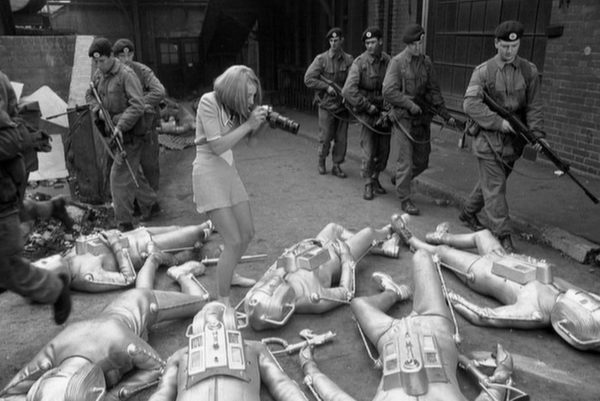
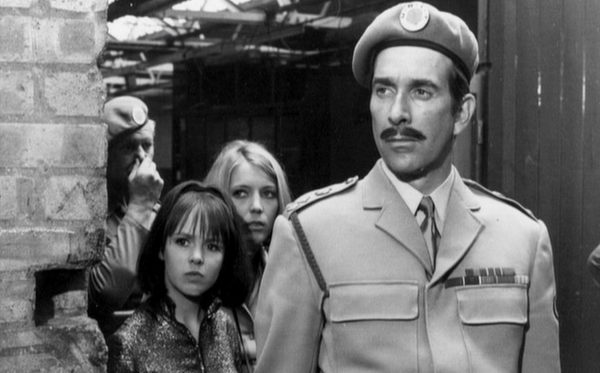
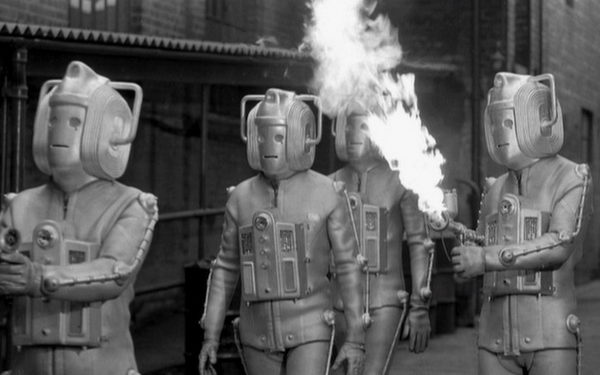
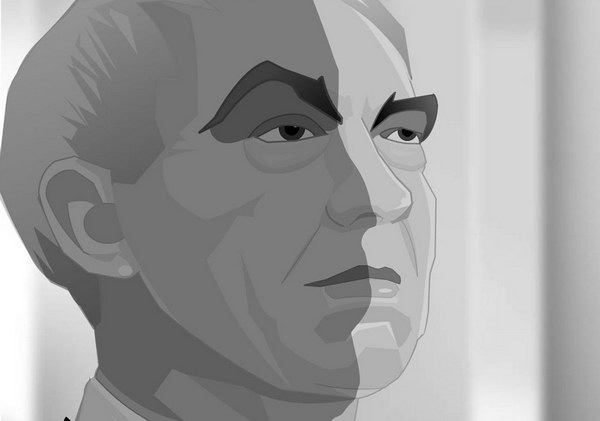
.jpg)


